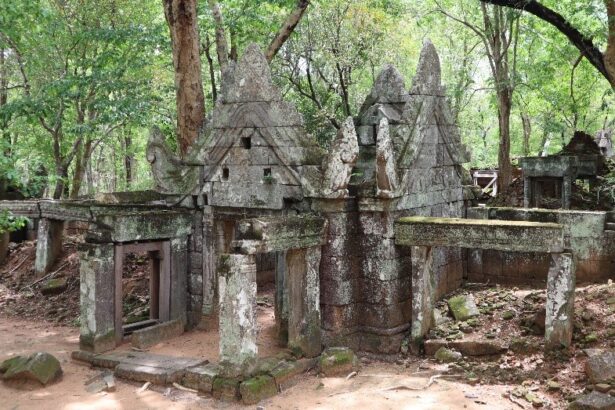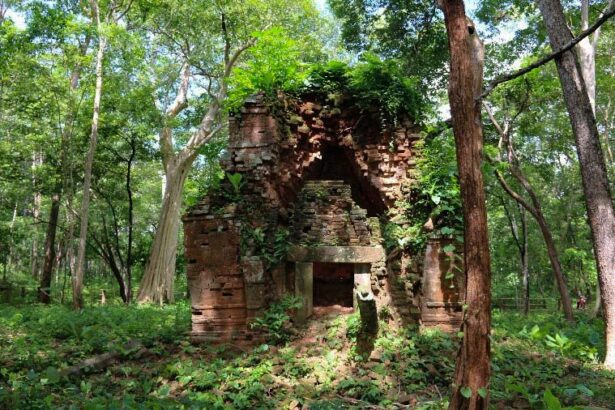Bayon temple is a well-known and richly decorated Khmer temple in the Angkor area in Cambodia. Built in the late 12th or early 13th century as the official state temple of the Mahayana Buddhist King Jayavarman VII, the Bayon stands at the center of Jayavarman’s capital, Angkor Thom. According to their respective religious inclinations, succeeding Hindu and Theravada monarchs rebuilt and expanded it after Jayavarman’s demise.
A Brief History of Bayon Temple

The Bayon temple was the last state structure to be completed at Angkor, Siem Reap, Cambodia. It was also the only Angkorian temple constructed solely as a Mahayana Buddhist temple devoted to the Buddha.
Jayavarman VII’s huge agenda of the monumental buildings and public works included the architecture of Angkor Thom’s walls, naga bridges, Preah Khan, Ta Prohm, Banteay Kdei temples, and others.
It’s been hypothesized by several experts that the 216 giant faces represent Jayavarman VII on the temple’s towers since they look so much like previous statues of the king.
Bayon Temple At A Glance
The mesmerizing, though little perplexing, state temple of Jayavarman VII, built in the 12th century, is at the center of Angkor Thom. The kingdom’s artistic talent and enormous ambition exemplify this work of art.
The 216 enormous smiling Avalokiteshvara faces ornament its 54 Gothic towers, and 1.2 kilometers of remarkable bas-reliefs feature more than 11,000 figures.
Bayon has a lot of secrecy around it, including its characteristics and meaning, which is fitting for a landmark that bears its name with a surreal smile.
At first glance, Bayon appears more like a legendary stack of ruins than a majestic temple. However, only after you explore the temple and ascend to the third floor can you truly appreciate its power.
The Bayon Temple’s Architectural Masterpiece
The architectural boldness was a definite political gesture about the transition from Hinduism to Mahayana Buddhism.
As the ‘face temple, these enormous heads gaze down from every aspect, conveying majesty and authority with a sense of compassion. With this mix, Jayavarman VII could maintain control over such a huge kingdom, assuring its people complied with his generous wishes.
Each head is apparent at any given time in full-face or profile, occasionally aligned with your eyes and glaring down from a great height above you.
While Bayon’s construction by Jayavarman VII is well-documented, its true history remains a mystery for years. It also took experts’ significant research to recognize that it is located in the middle of the city of Angkor Thom, encircled by dense forest.
The Grand Buildings of Bayon Temple
The primary structure of Bayon consists of three levels, each of which roughly corresponds to a different period of construction.
Once a stage had been accomplished, he would go on to the following in the process. Bas-reliefs decorate the first two floors, which are square and ornamented with geometric patterns. Third, these stairs reach the circular level with the towers and their faces.
At the time of Bayon’s architecture, the Khmer kingdom was assumed to be subdivided into 54 provinces; hence, the 54 all-seeing eyes watching over the kingdom’s distant subjects were built.
The Crafts And Sculptures Of The Bayon Temple
Images of Cambodian daily life from the 12th century may be seen in the magnificent engravings on the first level’s an outside wall. Compared to the gigantic first-level bas-reliefs, those on the second level have smaller scales and are more fractured.
The first bas-relief, Chams on the Run, is located immediately south of the east entrance and is a three-level panoramic. Khmer warriors march into combat on elephants and oxcarts that look almost exactly like those used in Cambodia today, as shown on the top tier of the pyramid.
In the second tier, soldiers are returning from the fight with coffins. Finally, atop the third layer, Jayavarman VII is depicted on horseback, flanked by an army of concubines who shield him from the sun (to the left).
In the next panel, Hindus worship before a linga in the northeastern corner (phallic symbol). Initially, this picture was presumably a Buddha, but a Hindu ruler altered it to seem more like his own image.
Some of the finest exemptions may be seen on the Naval Battle panel. For example, Khmers and Chams engaged in naval combat at the Tonlé Sap lake, where they were engaged in warfare.
What’s The Narration Behind Bayon Temple’s Name?
Jayagiri was the ancient name of Bayon (Victory Mountain). It was eventually renamed the Banyan Temple because of its religious importance and Buddhist iconography during the French occupation (the Buddha is said to have attained enlightenment under the Banyan tree).
During the renovation of the Banyan temple, the local Khmer workers made a linguistic blunder by pronouncing Banyan as Bayon. As a result, the name became a permanent fixture.
Numerous towers protrude from the top terrace and form a cluster around the peak position of the Bayon. However, its most distinguishing characteristic is the diversity of tranquil and enormous stone faces.
The temple’s bas-reliefs depict a unique mix of mythical, historical, and everyday situations.
Unlike Angkor Wat‘s classical design, the Japanese Government Team for the Safeguarding of Angkor (the JSA) describes the temple as “the most spectacular manifestation of the baroque style” of Khmer architecture.
Why And When Should You Visit Bayon Temple?
When it comes to visiting the Angkor Archaeological Park, skipping out on the chance to witness the calm stone faces of Bayon would be a huge regret.
The truth is, with Angkor Wat and Ta Prom, Bayon is one of the “big three” attractions in Angkor that every tourist should see.
The bas-relief sculptures on display at the site portray a unique mix of historical, mythological, and everyday life subjects in various styles.
Bayon is a smaller temple than many others, but you’ll need at least two hours to explore its maze of rooms, passageways, and climbing stairways. Bayon is a wonderful place to visit at any time of the day, but if you want to escape the crowd, go later in the afternoon when there is more shade.
There are several picture ops around every corner, and a tour guide can assist you in finding the greatest ones, like the “nose-to-nose” pose with a big head. Because of the temple’s intricate design and the surrounding trees’ shading, the light play varies greatly throughout the day.
Bayon temple of Angkor Thom is one of many ruins situated in the Angkor area, literally means that this temple is also a part of 401 square kilometers-Heritage of Humanity and World Wonder by UNESCO on 14th December 1992.
Gallery









